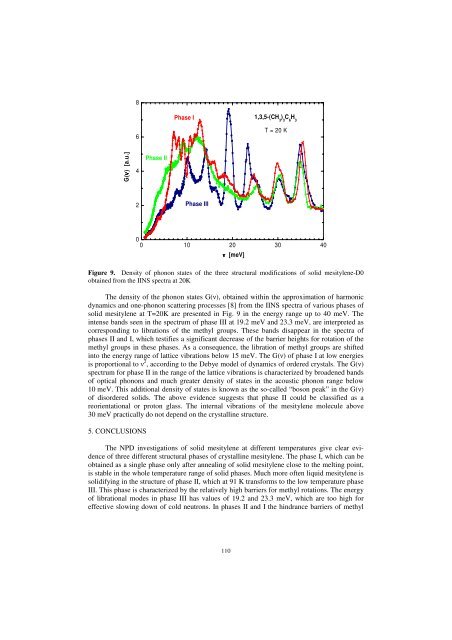Druck-Materie 20b.qxd - JUWEL - Forschungszentrum Jülich
Druck-Materie 20b.qxd - JUWEL - Forschungszentrum Jülich
Druck-Materie 20b.qxd - JUWEL - Forschungszentrum Jülich
You also want an ePaper? Increase the reach of your titles
YUMPU automatically turns print PDFs into web optimized ePapers that Google loves.
G(ν) [a.u.]<br />
8<br />
6<br />
4<br />
2<br />
Phase II<br />
Phase I<br />
Phase III<br />
0<br />
0 10 20 30 40<br />
ν [meV]<br />
110<br />
1,3,5-(CH 3 ) 3 C 6 H 3<br />
T = 20 K<br />
Figure 9. Density of phonon states of the three structural modifications of solid mesitylene-D0<br />
obtained from the IINS spectra at 20K<br />
The density of the phonon states G(ν), obtained within the approximation of harmonic<br />
dynamics and one-phonon scattering processes [8] from the IINS spectra of various phases of<br />
solid mesitylene at T=20K are presented in Fig. 9 in the energy range up to 40 meV. The<br />
intense bands seen in the spectrum of phase III at 19.2 meV and 23.3 meV, are interpreted as<br />
corresponding to librations of the methyl groups. These bands disappear in the spectra of<br />
phases II and I, which testifies a significant decrease of the barrier heights for rotation of the<br />
methyl groups in these phases. As a consequence, the libration of methyl groups are shifted<br />
into the energy range of lattice vibrations below 15 meV. The G(ν) of phase I at low energies<br />
is proportional to ν 2 , according to the Debye model of dynamics of ordered crystals. The G(ν)<br />
spectrum for phase II in the range of the lattice vibrations is characterized by broadened bands<br />
of optical phonons and much greater density of states in the acoustic phonon range below<br />
10 meV. This additional density of states is known as the so-called “boson peak” in the G(ν)<br />
of disordered solids. The above evidence suggests that phase II could be classified as a<br />
reorientational or proton glass. The internal vibrations of the mesitylene molecule above<br />
30 meV practically do not depend on the crystalline structure.<br />
5. CONCLUSIONS<br />
The NPD investigations of solid mesitylene at different temperatures give clear evidence<br />
of three different structural phases of crystalline mesitylene. The phase I, which can be<br />
obtained as a single phase only after annealing of solid mesitylene close to the melting point,<br />
is stable in the whole temperature range of solid phases. Much more often liquid mesitylene is<br />
solidifying in the structure of phase II, which at 91 K transforms to the low temperature phase<br />
III. This phase is characterized by the relatively high barriers for methyl rotations. The energy<br />
of librational modes in phase III has values of 19.2 and 23.3 meV, which are too high for<br />
effective slowing down of cold neutrons. In phases II and I the hindrance barriers of methyl

















